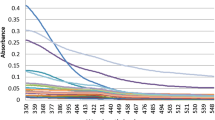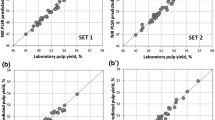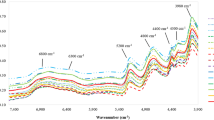Abstract
A new strategy was proposed to determine the Kappa number of bleached Eucalyptus globulus kraft pulps based on FT-Raman spectroscopy. Before modeling, smoothing (Savitzky-Golay), baseline correction (air-PLS), and Gaussian fitting were executed for obtaining data, including peak intensities and areas, from the Raman spectra. Two different Raman peaks, namely 1096 cm−1 and 2895 cm−1, were preset to normalize the lignin-related peak of 1600 cm−1. Therefore, two data types and two internal standard peaks were utilized to calculate ratios of selected peak intensities and peak areas. Then, they were interpreted as independent variables in the establishment of predicting model via Regression analysis. Among four different models, comparison of evaluations suggested that the value of peak intensity was superior to the value of area as an inputting value and the peak located at 2895 cm−1 performed marginally better than 1096 cm−1 as an internal standard. Statistical evaluation of the optimal predictive model, which presented as R is 0.91, RMSE is 0.46 and MAE is 0.36, indicated that the model is reliable. Therefore, the model has the high potential of accurately monitoring the Kappa number of bleached pulp and then could be helpful to reducing the extra chemical and energy consumptions in the pulp and paper industry.
Graphical abstract






Similar content being viewed by others
References
Agarwal UP (2019) Analysis of cellulose and lignocellulose materials by raman spectroscopy: a review of the current status. Molecules 24:1659
Agarwal UP (1999) An Overview of raman spectroscopy as applied to lignocellulosic materials. In: Argyropoulos D (ed) Advances in lignocellulosics characterization., 1st edn. TAPPI Press, pp 201–225
Agarwal UP (2014) 1064 nm FT-Raman spectroscopy for investigations of plant cell walls and other biomass materials. Front Plant Sci 5:490
Agarwal UP, Kawai N (2005) “Self-absorption” phenomenon in near-infrared fourier transform raman spectroscopy of cellulosic and lignocellulosic materials. Appl Spectrosc 59:385–388
Agarwal UP, Rajai H (2010) Vibrational spectroscopy. In: Cyril Heitner, Don Dimmel JA, Schmidt. (eds) Lignin and lignans: advances in chemistry. Taylor & Francis, Boca Raton, pp 103–136
Agarwal UP, Ralph SA (2008) Determination of ethylenic residues in wood and TMP of spruce by FT-Raman spectroscopy. Holzforschung 62:667–675
Agarwal UP, Ralph SA, Reiner RS, Baez C (2018) New cellulose crystallinity estimation method that differentiates between organized and crystalline phases. Carbohyd Polym 190:262–270
Agarwal UP, Weinstock IA, Atalla RH (2003) FT-Raman spectroscopy for direct measurement of lignin concentrations in kraft pulps. Tappi J 2:22–26
Altman N, Krzywinski M (2015) Points of significance: simple linear regression. Nat Methods 12:999–1000
Bajpai P (2015) Green chemistry and sustainability in pulp and paper industry, 1st edn. Springer International Publishing, pp 65–84
Bajpai P (2018) Pulping fundamentals. In: Bajpai P (ed) Biermann’s handbook of pulp and paper, 3rd edn. Elsevier, Third Edit, pp 295–351
Butler HJ, Ashton L, Bird B et al (2016) Using Raman spectroscopy to characterize biological materials. Nat Protoc 11:664–687
Chai T, Draxler RR (2014) Root mean square error (RMSE) or mean absolute error (MAE)? – Arguments against avoiding RMSE in the literature. Geosci Model Dev 7:1247–1250
Colodette JL, Gomide JL, Girard R et al (2002) Influence of pulping conditions on eucalyptus kraft pulp yield, quality, and bleachability. Tappi J 85:14–20
Ding D, Zhou X, You T et al (2018) Exploring the mechanism of high degree of delignification inhibits cellulose conversion efficiency. Carbohyd Polym 181:931–938
Fernández-Rodríguez J, Erdocia X, Hernández-Ramos F et al (2018) Lignin separation and fractionation by ultrafiltration. In: Zaliva K (ed) Separation of functional molecules in food by membrane technology, 1st edn. Elsevier, London, pp 229–265
Foster EJ, Moon RJ, Heux L et al (2018) Current characterization methods for cellulose nanomaterials. Chem Soc Rev 47:2609–2679
Gao W, Shu T, Liu Q et al (2021) Predictive modeling of lignin content for the screening of suitable poplar genotypes based on fourier transform-raman spectrometry. ACS Omega 6:8578–8587
China National Standards GB/T 1546–2018 (2018) Pulp-determination of Kappa number. China Standardization Administration, Beijing, China
Hauke J, Kossowski T (2011) Comparison of values of pearson’s and spearman’s correlation coefficients on the same sets of data. Quaestiones Geographicae 30:87–93
Liang L, Wei L, Fang G et al (2020) Prediction of holocellulose and lignin content of pulp wood feedstock using near infrared spectroscopy and variable selection. Spectrochim Acta A 225:117515
Lin SY, Dence CW (1992) Methods in Lignin Chemistry, 1st edn. Springer Series in Wood Science, Springer Verlag, Berlin, Heidelberg, p 578
Luiza A, Brian PQ, Jayprakash MK et al (2021) Investigating microcrystalline cellulose crystallinity using Raman spectroscopy. Cellulose 28:8971–8985
Lupoi JS, Singh S, Simmons BA, Henry RJ (2014) Assessment of lignocellulosic biomass using analytical spectroscopy: an evolution to high-throughput techniques. Bioenerg Res 7:1–23
Madden HH (1978) Comments on the Savitzky-Golay convolution method for least-squares-fit smoothing and differentiation of digital data. Anal Chem 50:1383–1386
Małachowska E, Dubowik M, Boruszewski P et al (2020) Influence of lignin content in cellulose pulp on paper durability. Sci Rep 10:1–12
Risén J, Hultén AH, Paulsson M (2004) Influence of fiber properties on the network strength of softwood and hardwood kraft pulp fibers from different stages of a bleaching sequence. J Wood Chem Technol 24:289–306
Sixta H (2006) Handbook of pulp. WILEY-VCH Verlag GmbH & Co, KGaA, Weinheim, Germany
Tappi T236 om-13 (2013) Kappa number of pulp. The Technological Association of the Pulp and Paper Industry, Atlanta, GA
Tofani G, Cornet I, Tavernier S (2021) Estimation of hydrogen peroxide effectivity during bleaching using the Kappa number. Chem Pap 75:5749–5758
Walker JCF (2006) Primary wood processing, 2nd edn. Springer, Dordrecht
Wenz JJ (2018) Examining water in model membranes by near infrared spectroscopy and multivariate analysis. BBA-Biomembranes 1860:673–682
Wiley JH, Atalla RH (1987) Band assignments in the Raman spectra of celluloses. Carbohyd Res 160:113–129
Willmott CJ, Matsuura K (2005) Advantages of the mean absolute error (MAE) over the root mean square error (RMSE) in assessing average model performance. Clim Res 30:79–82
Zhang ZM, Chen S, Liang YZ (2010) Baseline correction using adaptive iteratively reweighted penalized least squares. Analyst 135:1138–1146
Acknowledgments
Wenli Gao and Liang Zhou are contributed equally to this work and should be considered co-first authors. This work was supported by the National Natural Science Foundation of China (No. 31770596).
Funding
National natural science foundation of China, No. 31770596, Liang Zhou
Author information
Authors and Affiliations
Contributions
Data analysis and Writing-original draft preparation: WG; Conceptualization and Writing—review and editing: YG; Resources: HG; Supervision: SL; Writing-original draft, review, and editing, Funding acquisition and Supervision: LZ.
Corresponding authors
Ethics declarations
Conflict of interest
The authors declare no conflicts of interest.
Human and animal participants
This article does not contain any studies involving animals or human participants performed by any of the authors.
Additional information
Publisher's Note
Springer Nature remains neutral with regard to jurisdictional claims in published maps and institutional affiliations.
Rights and permissions
About this article
Cite this article
Gao, W., Zhou, L., Guan, Y. et al. Monitoring the kappa number of bleached pulps based on FT-Raman spectroscopy. Cellulose 29, 1069–1080 (2022). https://doi.org/10.1007/s10570-021-04333-4
Received:
Accepted:
Published:
Issue Date:
DOI: https://doi.org/10.1007/s10570-021-04333-4




